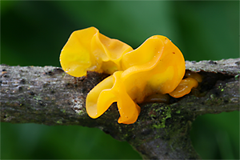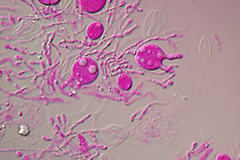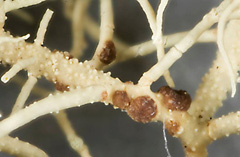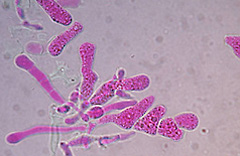Ana Millanes

Ana Millanes. Photo: Martin Westberg
Ana Millanes lives and works in Madrid. During five weeks in the spring of 2008 she visited the Department of Cryptogamic Botany, working with a survey of the morphological characters of the group Tremellales. It was a colleague at the home University who recommended her to visit NRM and Mats Wedin, Senior curator and Ana´s host, at first. The visit was giving her the opportunity to study the invaluable material preserved in the Cryptogamic herbarium as well as learning a lot from her host Mats Wedin, who "is a very friendly and experienced supervisor", Ana said.
She was very fond of Stockholm which she thinks is a beautiful town with all the water in and around it. Ana has been to several museums in the city, for example Skansen, Vasamuseet and Moderna museet, and of course the exhibitions at our museum.
Ana appreciated to live in “the Black villa", with rooms for guest researchers nearby the museum. She didn´t have to waste any time on transports and could be very flexible. "You have to make an effort to get outside the museum area though", Ana said.
Project description
The Tremellales are an extremely interesting group of fungi due to different reasons. The amount of diversity in the group is still not well known and new species are continuously being discovered and described. The group includes common species of “jelly fungi" as Tremella mesenterica (“Witch´s butter") or the popular Tremella fuciformis (“Snow fungus"), an edible species of the group, whose chemical compounds are being investigated with medicinal purposes. But there are many other fascinating and poorly known species in the group, including fungi growing as gall-forming parasites on other fungi including lichens. The morphology and consistency of these galls are variable but they generally appear as swollen parts on the lichen thallus, with a similar or different colour from the host (see the picture of Biatoropsis usnearum). Here, the number of accepted species has increased enormously recently and is expected to rise further in the future. It is therefore necessary to update the current classification including all representatives described so far, specially those that grow on lichens (the lichenicolous species), and clarify the phylogenetic relationships within the group.

Tremella mesenterica. Photo: Juan Santos

Tremella mesenterica (basidia)
Apart from their general classification and systematics, other open questions about these fungi are still waiting to be answered. From an evolutionary approach is extremely interesting the diverse lifestyles that different species of Tremellales adopt, including saprotrophs, fungicolous (fungal-inhabiting) and lichenicolous (lichen inhabiting). The nature of their association with other fungi is poorly understood as well as its evolutionary interpretation. Moreover, the lichenicolous species are highly specific to the host, suggesting that a pattern of co-evolution could exist between some groups of tremellalean fungi and their lichen hosts.

Biatoropsis usnearum. Photo: Ramona Ubral-Hedenberg

Biatoropsis usnearum (basidia)
In the frame of this project, the aim of my Synthesysvisit has been to complete an exhaustive survey of the morphological characters of the group, studying representatives showing all possible nutritional habits, in order to identify traits of systematic interest. This is the first time where lichenicolous taxa are included in a general phylogeny of the group, and where this molecular phylogeny will be utilised for a thorough study of morphological evolution. For this purpose, it has been really positive and helpful to have the opportunity to study the invaluable material preserved in the Cryptogamic Herbarium of the Swedish Museum of Natural History. This collection contains an impressive number of Tremellalean specimens, representing 52 species of lichenicolous and 35 species of non-lichenicolous fungi. This large number of taxa belonging to Tremellaes, including many types, is probably unique among the herbaria in Europe.


